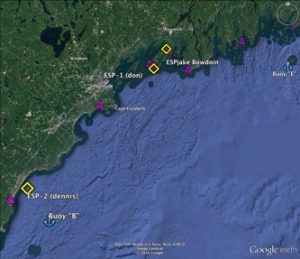2016 Bloom Season

Fig. 1. Location of ESP deployments for 2016 (diamonds). Shellfish monitoring sites (purple triangles) and NOAA-NERACOOS moorings (anchors) are also shown.
The Alexandrium catenella bloom in 2016 was detected in low concentrations by 3 ESP instruments deployed in the western Gulf of Maine. Two ESPs were located in Casco Bay, ME and off of Ogunquit, ME, both within 1 nautical mile from ME DMR shellfish monitoring sites. A third ESP was located in a wetlab at Bowdoin College Coastal Facility with wild mussels placed in an adjacent tray near the ESP intake. Lumbos Hole, a local hotspot for shellfish toxicity, is near the wetlab (see Fig. 1).
The 3 ESPs consistently detected the presence of A. catenella in low concentrations (~200 cells/Liter) early in the bloom season (May), but the weak bloom ended early without further development in June, consistent with the detection of low levels of shellfish toxicity in the region. Near real time data streamed from the 3 ESPs during the season and is available on WHOI’s ESP server at:
http://science.whoi.edu/esp/fieldcelldata
These results indicated that the A. catenella bloom never fully developed into significant populations in the western Gulf of Maine in 2016. Along the eastern Maine coast, shellfish toxicity was also low suggesting either that an offshore bloom in eastern Maine never reached the shoreline or the lack of a significant bloom in 2016 was Gulf-wide. The ESP and shellfish toxicity observations were consistent with the seasonal “small” bloom forecast that was based on the low abundance of A. catenella benthic cysts collected during the preceding Fall season (Nov. 2015) from the NOAA ship Henry Bigelow.
